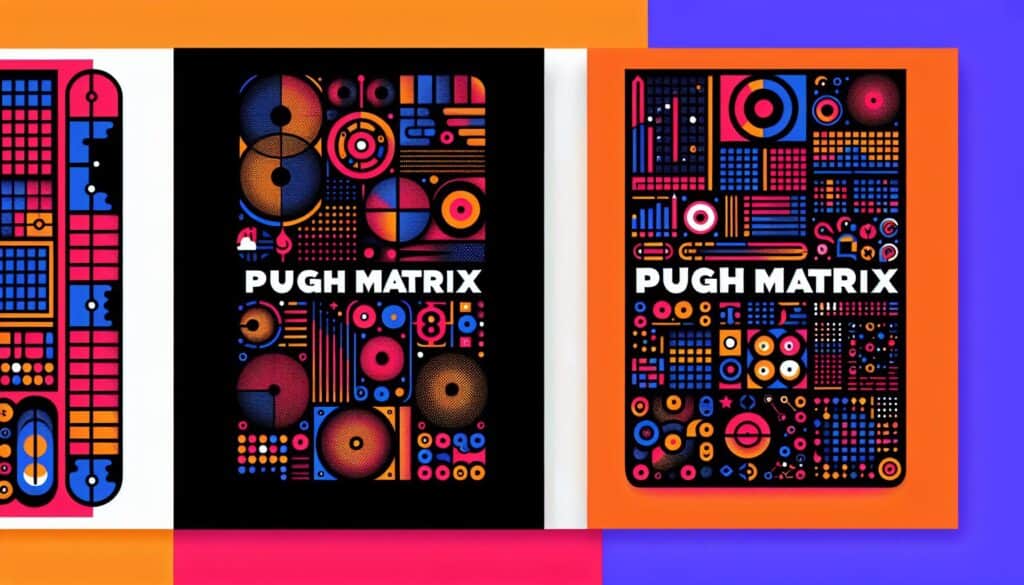To systematically evaluate and compare multiple concepts or solutions against a baseline concept and a set of criteria.
- Methodologien: Kunden & Marketing, Wirtschaft, Produktdesign
Pugh Matrix

Pugh Matrix
- Agile Methodik, Bewertung des Designs, Design für Nachhaltigkeit, Multiple-Kriterien-Entscheidungsfindung (MCDM), Prozessverbesserung, Produktentwicklung, Projektmanagement, Einsatz von Qualitätsfunktionen (QFD), Risikomanagement
Zielsetzung:
Wie es verwendet wird:
- A matrix is created with concepts listed as rows and evaluation criteria as columns. Each concept is compared to a baseline concept (datum) for each criterion, scoring it as better (+), worse (-), or same (S). Scores are then tallied.
Vorteile
- Provides a structured and objective way to compare alternatives; helps identify strengths and weaknesses of each concept; facilitates group consensus.
Nachteile
- The selection of criteria and the baseline concept can significantly influence results; scoring can be subjective if criteria are not well-defined; does not inherently weight criteria.
Kategorien:
- Maschinenbau, Problemlösung, Produktdesign
Am besten geeignet für:
- Selecting the most promising concept from a set of alternatives based on multiple criteria.
Pugh Matrix methodology proves beneficial in various stages of product design and development across multiple sectors, such as consumer electronics, automotive, and aerospace engineering, where innovation is a priority. This approach is particularly effective during the concept selection phase, where teams must evaluate diverse design alternatives against established performance metrics such as cost, usability, manufacturability, and sustainability. Cross-functional teams, comprising members from engineering, marketing, and user experience design, can collectively participate in this evaluation, ensuring that diverse perspectives are considered, leading to more robust decision-making. Competitors like the Quality Function Deployment (QFD) can complement this methodology by integrating customer requirements into the design process. By establishing a datum concept, teams can assess new ideas against a familiar benchmark, offering clarity and focus in the decision-making process. The scoring can illuminate aspects where certain concepts excel or fall short, offering clear visibility into potential risks and opportunities. This methodology encourages a thorough discussion among stakeholders and helps build consensus, which is particularly important in environments where iterative feedback and rapid prototyping are prevalent. Examples from industries highlight its utility; for instance, a team in the automotive industry may use the Pugh Matrix when evaluating new vehicle features, while a tech company may apply it to prioritize software functionalities, effectively guiding their development Roadmap. Successful implementation of this methodology can result in efficient allocation of resources, reducing time and costs associated with pursuing less viable ideas and ultimately accelerating the innovation cycle.
Die wichtigsten Schritte dieser Methodik
- Create a Pugh Matrix with concepts as rows and criteria as columns.
- Select a baseline or datum concept for comparison.
- Score each concept against the datum for each criterion using +, -, or S.
- Aggregate scores for each concept across all criteria.
- Analyze scores to compare strengths and weaknesses of each concept.
- Identify the most promising concept based on aggregated scores.
Profi-Tipps
- Involve a diverse group of stakeholders during evaluation to capture varying perspectives that may highlight important but overlooked criteria.
- Regularly revisit and update the baseline concept to ensure it reflects current market conditions and technological advancements.
- Assign weights to evaluation criteria based on strategic priorities to enhance decision relevance and align with organizational goals.
Verschiedene Methoden lesen und vergleichen, Wir empfehlen die
> Umfassendes Methoden-Repository <
zusammen mit den über 400 anderen Methoden.
Ihre Kommentare zu dieser Methodik oder zusätzliche Informationen sind willkommen auf der Kommentarbereich unten ↓ , sowie alle ingenieursbezogenen Ideen oder Links.
Historischer Kontext
1949
1950
1950
1960
1960
1960
1960
1940
1950
1950
1958
1960
1960
1960
1960
(wenn das Datum nicht bekannt oder nicht relevant ist, z. B. "Strömungsmechanik", wird eine gerundete Schätzung des bemerkenswerten Erscheinens angegeben)















Verwandte Artikel
Fragebögen zu muskuloskelettalen Beschwerden
Multivariate Tests (MVT)
Mehrfache Regressionsanalyse
Motion-Capture-Systeme
MoSCoW-Methode
Moods Median-Test